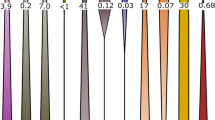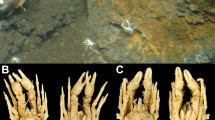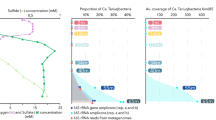Abstract
Chemosynthetic mats involved in cycling sulfur compounds are often found in hydrothermal vents, cold seeps and whale falls. However, there are only few records of wood fall mats, even though the presence of hydrogen sulfide at the wood surface should create a perfect niche for sulfide-oxidizing bacteria. Here we report the growth of microbial mats on wood incubated under conditions that simulate the Mediterranean deep-sea temperature and darkness. We used amplicon and metagenomic sequencing combined with fluorescence in situ hybridization to test whether a microbial succession occurs during mat formation and whether the wood fall mats present chemosynthetic features. We show that the wood surface was first colonized by sulfide-oxidizing bacteria belonging to the Arcobacter genus after only 30 days of immersion. Subsequently, the number of sulfate reducers increased and the dominant Arcobacter phylotype changed. The ecological succession was reflected by a change in the metabolic potential of the community from chemolithoheterotrophs to potential chemolithoautotrophs. Our work provides clear evidence for the chemosynthetic nature of wood fall ecosystems and demonstrates the utility to develop experimental incubation in the laboratory to study deep-sea chemosynthetic mats.
Similar content being viewed by others
Log in or create a free account to read this content
Gain free access to this article, as well as selected content from this journal and more on nature.com
or
References
Alain K, Zbinden M, Le Bris N, Lesongeur F, Quérellou J, Gaill F et al. (2004). Early steps in microbial colonization processes at deep-sea hydrothermal vents. Environ Microbiol 6: 227–241.
Amann RI, Binder BJ, Olson RJ, Chisholm SW, Devereux R, Stahl DA . (1990). Combination of 16S rRNA-targeted oligonucleotide probes with flow cytometry for analyzing mixed microbial populations. Appl Environ Microb 56: 1919–1925.
Ben-Dov E, Siboni N, Shapiro OH, Arotsker L, Kushmaro A . (2011). Substitution by inosine at the 3′-ultimate and penultimate positions of 16 S rRNA gene universal primers. Microb Ecol 61: 1–6.
Bienhold C, Pop Ristova P, Wenzhöfer F, Dittmar T, Boetius A . (2013). How deep-sea wood falls sustain chemosynthetic life. Plos One 8: e53590.
Blair NE, Aller RC . (2012). The fate of terrestrial organic carbon in the marine environment. Annu Rev Marine Sci 4: 401–423.
Blazejak A, Erséus C, Amann R, Dubilier N . (2005). Coexistence of bacterial sulfide oxidizers, sulfate reducers, and spirochetes in a gutless worm (Oligochaeta) from the Peru margin. Appl Environ Microb 71: 1553–1561.
Camacho C, Coulouris G, Avagyan V, Ma N, Papadopoulos J, Bealer K et al. (2009). BLAST+: architecture and applications. BMC Bioinformatics 10: 421.
Campbell BJ, Cary SC . (2004). Abundance of reverse tricarboxylic acid cycle genes in free-living microorganisms at deep-sea hydrothermal vents. Appl Environ Microb 70: 6282–6289.
Campbell BJ, Engel AS, Porter ML, Takai K . (2006). The versatile |[epsi]|-proteobacteria: key players in sulphidic habitats. Nat Rev Micro 4: 458–468.
Cox MP, Peterson DA, Biggs PJ . (2010). SolexaQA: at-a-glance quality assessment of Illumina second-generation sequencing data. BMC Bioinformatics 11: 485.
Duperron S, Laurent MC, Gaill F, Gros O . (2008). Sulphur-oxidizing extracellular bacteria in the gills of Mytilidae associated with wood falls. FEMS Microbiol Ecol 63: 338–349.
Edgar RC, Haas BJ, Clemente JC, Quince C, Knight R . (2011). UCHIME improves sensitivity and speed of chimera detection. Bioinformatics 27: 2194–2200.
Fagervold SK, Bessette S, Romano C, Martín D, Plyuscheva M, Le Bris N et al. (2013). Microbial communities associated with the degradation of oak wood in the Blanes submarine canyon and its adjacent open slope (NW Mediterranean). Prog Oceanogr 118: 137–143.
Fagervold SK, Romano C, Kalenitchenko, Borowski C, Nunes-Jorge A, Martin D et al. (2014). Microbial communities in sunken wood are structured by wood-boring bivalves and location in a submarine canyon. Plos One 9: e96248.
Felden J (2009). Biogeochemical processes associated with mud volcanism on the Nile Deep Sea580 Fan – the Amon mud volcano. In: Methane Fluxes and Associated Biogeochemical Processes in Cold581 Seep Ecosystems. Jacobs University Bremen/Max Planck Institute for Marine Microbiology: Bremen, Germany, pp 51–77.
Flemming H-C, Wingender J . (2010). The biofilm matrix. Nat Rev Microbiol 8: 623–633.
Flint HJ, Bayer EA, Rincon MT, Lamed R, White BA . (2008). Polysaccharide utilization by gut bacteria: potential for new insights from genomic analysis. Nat Rev Microbiol 6: 121–131.
Garrity GM, Holt JG . (2001). Phylum BIX. Deferribacteres phy. nov In: Boone DR, Castenholz RW (eds) Bergeys Manual of Systematic Bacteriology 2nd edn, Vol 1 Springer-Verlag: New York, NY, USA, pp 465–471.
Gentz T, Schlüter M . (2012). Underwater cryotrap-membrane inlet system (CT-MIS) for improved in situ analysis of gases. Limnol Oceanogr-Meth 55: 2366–2380.
Girnth AC, Grünke S, Lichtschlag A, Felden J, Knittel K, Wenzhöfer F et al. (2011). A novel, mat-forming thiomargarita population associated with a sulfidic fluid flow from a deep-sea mud volcano. Environ Microbiol 13: 495–505.
Golladay SW, Sinsabaugh RL . (1991). Biofilm development on leaf and wood surfaces in a boreal river. Freshwater Biol 25: 437–450.
Gomez-Alvarez V, Teal TK, Schmidt TM . (2009). Systematic artifacts in metagenomes from complex microbial communities. ISME J 3: 1314–1317.
Grünke S, Felden J, Lichtschlag A, Girnth AC, De Beer D, Wenzhöfer F et al. (2011). Niche differentiation among mat-forming, sulfide-oxidizing bacteria at cold seeps of the Nile Deep Sea Fan (Eastern Mediterranean Sea). Geobiology 9: 330–348.
Heijs SK, Damsté JSS, Forney LJ . (2005). Characterization of a deep-sea microbial mat from an active cold seep at the Milano mud volcano in the Eastern Mediterranean Sea. FEMS Microbiol Ecol 54: 47–56.
Hügler M, Gärtner A, Imhoff JF . (2010). Functional genes as markers for sulfur cycling and CO2 fixation in microbial communities of hydrothermal vents of the Logatchev field. FEMS Microbiol Ecol 73: 526–537.
Hügler M, Sievert SM . (2011). Beyond the calvin cycle: autotrophic carbon fixation in the ocean. Annu Rev Marine Sci 3: 261–289.
Jørgensen BB, Fossing H, Wirsen CO, Jannasch HW . (1991). Sulfide oxidation in the anoxic Black Sea chemocline. Deep Sea Res 38: S1083–S1103.
Kalenitchenko Fagervold SK, Pruski AM, Vétion G, Yücel M, Le Bris N et al. (2015). Temporal and spatial constraints on community assembly during microbial colonization of wood in seawater. ISME J 9: 2657–2670.
Kanehisa M . (2002). The KEGG database. Novartis Found Symp 247: 91–101.
Khelaifia S, Fardeau M-L, Pradel N, Aussignargues C, Garel M, Tamburini C et al. (2011). Desulfovibrio piezophilus sp. nov., a piezophilic, sulfate-reducing bacterium isolated from wood falls in the Mediterranean Sea. Int J Syst Evol Micr 61: 2706–2711.
Kozich JJ, Westcott SL, Baxter NT, Highlander SK, Schloss PD . (2013). Development of a dual-index sequencing strategy and curation pipeline for analyzing amplicon sequence data on the MiSeq Illumina sequencing platform. Appl Environ Microb 79: 5112–5120.
Laurent MCZ, Le Bris N, Gaill F, Gros O . (2013). Dynamics of wood fall colonization in relation to sulfide concentration in a mangrove swamp. Mar Environ Res 87-88: 85–95.
Lauro FM, DeMaere MZ, Yau S, Brown MV, Ng C, Wilkins D et al. (2011). An integrative study of a meromictic lake ecosystem in Antarctica. ISME J 5: 879–895.
Le Bris N, Govenar B, Le Gall C, Fisher CR . (2006). Variability of physico-chemical conditions in 9°50′N EPR diffuse flow vent habitats. Mar Chem 98: 167–182.
Leschine SB . (1995). Cellulose degradation in anaerobic environments. Annu Rev Microbiol 49: 399–426.
Lin X, Wakeham SG, Putnam IF, Astor YM, Scranton MI, Chistoserdov AY et al. (2006). Comparison of vertical distributions of prokaryotic assemblages in the anoxic Cariaco Basin and Black Sea by use of fluorescence in situ hybridization. Appl Environ Microb 72: 2679–2690.
Llorens-Marès T, Yooseph S, Goll J, Hoffman J, Vila-Costa M, Borrego CM et al. (2015). Connecting biodiversity and potential functional role in modern euxinic environments by microbial metagenomics. ISME J 9: 1648–1661.
López-García P, Duperron S, Philippot P, Foriel J, Susini J, Moreira D . (2003). Bacterial diversity in hydrothermal sediment and epsilonproteobacterial dominance in experimental microcolonizers at the Mid-Atlantic Ridge. Environ Microbiol 5: 961–976.
Manz W, Amann R, Ludwig W, Wagner M, Schleifer K-H . (1992). Phylogenetic oligodeoxynucleotide probes for the major subclasses of proteobacteria: problems and solutions. Syst Appl Microbiol 15: 593–600.
Meyer F, Paarmann D, D'Souza M, Olson R, Glass EM, Kubal M et al. (2008). The metagenomics RAST server - a public resource for the automatic phylogenetic and functional analysis of metagenomes. BMC Bioinformatics 9: 386.
Moran MA, Buchan A, González JM, Heidelberg JF, Whitman WB, Kiene RP et al. (2004). Genome sequence of Silicibacter pomeroyi reveals adaptations to the marine environment. Nature 432: 910–913.
Moussard H, Corre E, Cambon Bonavita M-A, Fouquet Y, Jeanthon C . (2006). Novel uncultured Epsilonproteobacteria dominate a filamentous sulphur mat from the 13 degrees N hydrothermal vent field, East Pacific Rise. FEMS Microbiol Ecol 58: 449–463.
Okabe S, Ito T, Sugita K, Satoh H . (2005). Succession of internal sulfur cycles and sulfur-oxidizing bacterial communities in microaerophilic wastewater biofilms. Appl Environ Microb 71: 2520–2529.
Pati A, Gronow S, Lapidus A, Copeland A, Glavina Del Rio T, Nolan M et al. (2010). Complete genome sequence of Arcobacter nitrofigilis type strain (CIT). Stand Genomic Sci 2: 300–308.
Pernthaler A, Pernthaler J, Amann R . (2002). Fluorescence in situ hybridization and catalyzed reporter deposition for the identification of marine bacteria. Appl Environ Microb 68: 3094–3101.
Prabagaran SR, Suresh K, Manorama R, Delille D, Shivaji S . (2005). Marinomonas ushuaiensis sp. nov., isolated from coastal sea water in Ushuaia, Argentina, sub-Antarctica. Int J Syst Evol Micr 55: 309–313.
Pradel N, Ji B, Gimenez G, Talla E, Lenoble P, Garel M et al. (2013). Thefirst genomic and proteomic characterization of a deep-sea sulfate reducer: insights into the piezophilic lifestyle of Desulfovibrio piezophilus. Plos One 8: e55130.
Pruesse E, Quast C, Knittel K, Fuchs BM, Ludwig W, Peplies J et al. (2007). SILVA: a comprehensive online resource for quality checked and aligned ribosomal RNA sequence data compatible with ARB. Nucleic Acids Res 35: 7188–7196.
Purchon RD . (1941). On the biology and relationships of the Lamellibranch Xylophaga Dorsalis (Turton). J Mar Biol Assoc UK 25: 1–39.
Rho M, Tang H, Ye Y . (2010). FragGeneScan: predicting genes in short and error-prone reads. Nucleic Acids Res 38: e191–e191.
Rickard D, Luther GW . (2007). Chemistry of iron sulfides. Chem Rev 107: 514–562.
Samadi S, Corbari L, Lorion J, Hourdez S, Haga T, Dupont J et al. (2010). Biodiversity of deep-sea organisms associated with sunken-wood or other organic remains sampled in the tropical Indo-Pacific. Cah Biol Mar 51: 459–466.
Santegoeds CM, Ferdelman TG, Muyzer G, de Beer D . (1998). Structural and functional dynamics of sulfate reducing populations in bacterial biofilms. Appl Environ Microb 64: 3731–3739.
Sievert SM, Wieringa EBA, Wirsen CO, Taylor CD . (2007). Growth and mechanism of filamentous-sulfur formation by Candidatus Arcobacter sulfidicus in opposing oxygen-sulfide gradients. Environ Microbiol 9: 271–276.
Sjostrom E . (1993) Wood Chemistry. Academic Press: San Diego, CA, USA.
Smith CJ, Nedwell DB, Dong LF, Osborn AM . (2007). Diversity and abundance of nitrate reductase genes (narG and napA), nitrite reductase genes (nirS and nrfA), and their transcripts in estuarine sediments. Appl Environ Microb 73: 3612–3622.
Sorokin DY . (2003). Oxidation of inorganic sulfur compounds by obligately organotrophic bacteria. Microbiology 72: 641–653.
Takai K, Campbell BJ, Cary SC, Suzuki M, Oida H, Nunoura T et al. (2005). Enzymatic and genetic characterization of carbon and energy metabolisms by deep-sea hydrothermal chemolithoautotrophic isolates of Epsilonproteobacteria. Appl Environ Microb 71: 7310–7320.
Tank JL, Webster JR . (1998). Interaction of substrate and nutrient availability on wood biofilm processes in streams. Ecology 79: 2168–2179.
Tank JL, Winterbourn MJ . (1995). Biofilm development and invertebrate colonization of wood in four New Zealand streams of contrasting pH. Freshwater Biol 34: 303–315.
Taylor C, Wirsen C, Gaill F . (1999). Rapid microbial production of filamentous sulfur mats at hydrothermal vents. Appl Environ Microb 65: 2253–2255.
Van Dover CL, Fry B . (1989). Stable isotopic compositions of hydrothermal vent organisms. Mar Biol 102: 257–263.
Van Houten RT, Pol LW, Lettinga G . (1994). Biological sulphate reduction using gas-lift reactors fed with hydrogen and carbon dioxide as energy and carbon source. Biotechnol Bioeng 44: 586–594.
Vandieken V . (2006). Desulfovibrio frigidus sp. nov. and Desulfovibrio ferrireducens sp. nov., psychrotolerant bacteria isolated from Arctic fjord sediments (Svalbard) with the ability to reduce Fe(III). Int J Syst Evol Micr 56: 681–685.
Voight JR . (2015). Xylotrophic bivalves: aspects of their biology and the impacts of humans. J Mollus Stud 81: 175–186.
Wirsen CO, Sievert SM, Cavanaugh CM, Molyneaux SJ, Ahmad A, Taylor LT et al. (2002). Characterization of an autotrophic sulfide-oxidizing marine Arcobacter sp. that produces filamentous sulfur. Appl Environ Microb 68: 316–325.
Yakimov MM, Giuliano L, Denaro R, Crisafi E, Chernikova TN, Abraham W-R et al. (2004). Thalassolituus oleivorans gen. nov., sp. nov., a novel marine bacterium that obligately utilizes hydrocarbons. Int J Syst Evol Micr 54: 141–148.
Yücel M, Galand PE, Fagervold SK, Contreira-Pereira L, Le Bris N . (2013). Sulfide production and consumption in degrading wood in the marine environment. Chemosphere 90: 403–409.
Acknowledgements
The present work was supported by the Agence Nationale de la Recherche (ANR) project MICADO (ANR-11JSV7-Q23-003-01). We acknowledge Erwan Peru for his help during the utilization of microsensors and we thank the BIO2MAR platform (http://bio2mar.obs-banyuls.fr) for providing technical support and access to instrumentation. We are also grateful to Julie Rius and Benjamin Falgas from the ‘Biodiversarium’ in Banyuls sur Mer for their kind and precious help in providing pinewood and Yannick Banuls from the laboratory carpentry for precisely cutting the wood logs.
Author information
Authors and Affiliations
Corresponding author
Ethics declarations
Competing interests
The authors declare no conflict of interest.
Additional information
Supplementary Information accompanies this paper on The ISME Journal website
Supplementary information
Rights and permissions
About this article
Cite this article
Kalenitchenko, D., Dupraz, M., Le Bris, N. et al. Ecological succession leads to chemosynthesis in mats colonizing wood in sea water. ISME J 10, 2246–2258 (2016). https://doi.org/10.1038/ismej.2016.12
Received:
Revised:
Accepted:
Published:
Issue date:
DOI: https://doi.org/10.1038/ismej.2016.12
This article is cited by
-
Preservation status and microbial community of waterlogged archaeological woods over 7800 years old at the Jingtoushan Site, China
Wood Science and Technology (2023)
-
Historical contingency impacts on community assembly and ecosystem function in chemosynthetic marine ecosystems
Scientific Reports (2021)
-
Horizontal acquisition of a patchwork Calvin cycle by symbiotic and free-living Campylobacterota (formerly Epsilonproteobacteria)
The ISME Journal (2020)
-
Bacteria alone establish the chemical basis of the wood-fall chemosynthetic ecosystem in the deep-sea
The ISME Journal (2018)
-
The early conversion of deep-sea wood falls into chemosynthetic hotspots revealed by in situ monitoring
Scientific Reports (2018)



